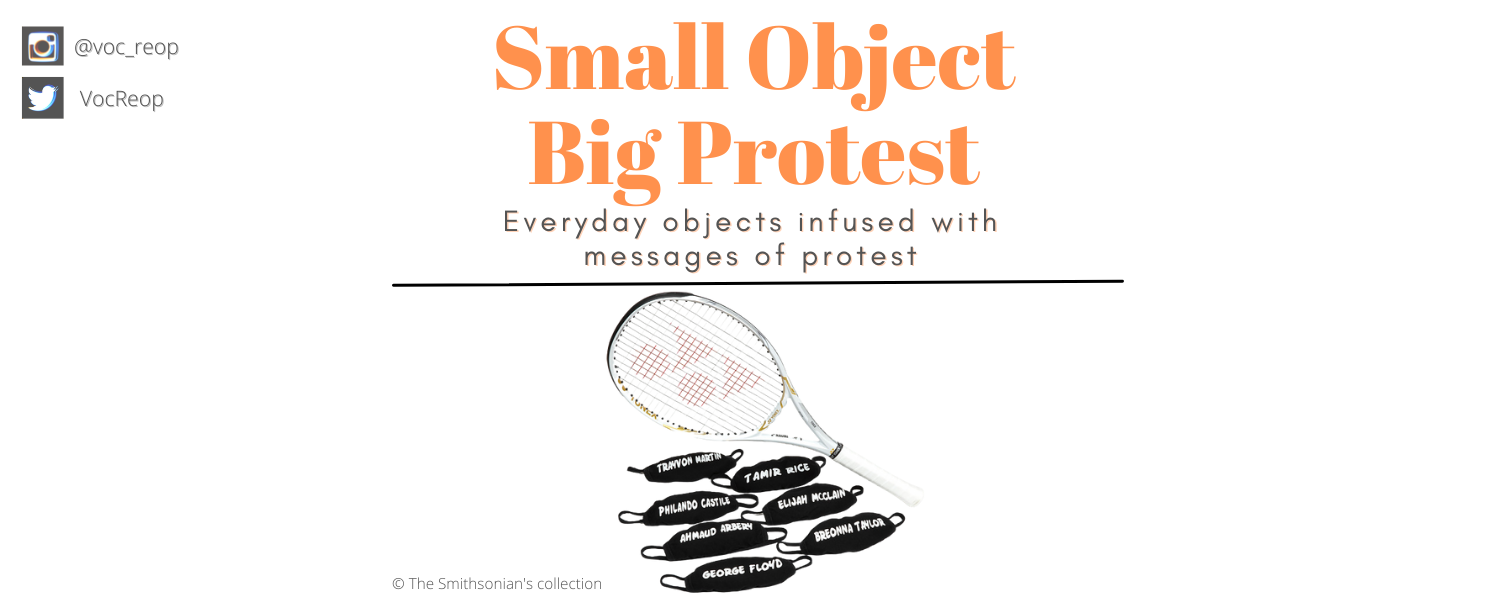No Stamp Act Teapot
Collection of the Smithsonian National Museum
1766-1770


The earliest form of protest in our collection, the ‘No Stamp Act’ teapot was made in England in the mid to late 18th century and sold to the American market. This particular teapot was made in correlation to the Stamp Act of 1765. The Stamp Act required Americans to pay a tax on printed materials such as documents.
Understandably, the Americans were furious at this tax and as a result, objects such as this teapot were produced to note the general feeling of unrest in America.
Allowing us to consider and question the longstanding use of household objects for protest if they were being used as early as the 18th century.
Straw sombrero hat associated with Civil Rights campaign, Camden, Alabama
National Museum of African American History and Culture, Gift of Rosetta M. Anderson
1971-1972


This straw hat was worn during the Civil Rights campaign in Alabama. Words such as ‘Peace’, ‘Love’, ‘Brother’, ‘Sister’ are written on the crown and underside of the brim representing unity and equality. With this the hat not only became an object of protest, but also a symbol of empowerment for the wearer and others fighting the same cause.
AIDS Awareness Trading Cards
Collection of the Smithsonian National Museum of American History
1993

Produced in 1993 in order to educate the public during the AIDS epidemic, these trading cards, a popular form of entertainment in the United States featured several well-known figures who had passed away due to AIDS, including Freddie Mercury.
However, they were also embroiled in controversy as the cards came with condoms. This decision worsened the public’s perception of the LGBT community, who featured heavily in the cards. As it unintentionally delivered the message that AIDS, and homosexuality are related.
Therefore, allowing us to question when an object is repurposed, how will the intended message spread through this object?
Afro Hair Comb with Black Fist
Collection of the Smithsonian National Museum of African American History and Culture, Gift of Elaine Nichols
2002-2014

The afro comb is a hair care tool used by many black people and is an object synonymous with black identity. The clenched fist on the top of the comb symbolises solidarity commonly associated with the Civil Rights movement and recently the Black Lives Matter movement. This transforms the object from a simple comb to the embodiment of pride and protest.
Universal Access Flag Lap Blanket
Collection of the Smithsonian National Museum of American History
2002

This commercial lap blanket was altered by disability-rights advocates to look like the American flag- a powerful symbol of freedom- with the universal access symbol made up of stitched stars. Here a modest item used passively in everyday life has been transformed into a form of agency within a wider narrative by giving a voice to people with lived experience who may otherwise be overlooked.
Umbrella – from the HK Umbrella Revolution
V&A Museum
2014

This simple black umbrella is painted with Chinese character, that means ‘to support’ and ‘to endure’, by the pro-democracy groups who protested in Hong Kong in September 2014.
The protests in Hong Kong have now become known as the ‘Umbrella Revolution’, as those who have protested use these umbrellas to shield themself from the rain but most importantly the tear gas fired by the police. By having an entire protest and political movement becoming associated with an umbrella allows us to consider the true impact and legacy of reclaiming objects for matters of protest.
Pussy Hat
Collection of the Smithsonian National Museum of American History
2017

During Trump’s Presidential campaign in 2016, he caused outrage across the world when he made vulgar comments about ‘grabbing women’s genitals. As a response to this Jayna Zweiman and Krista Suh decided to create a hat that was designed as a form of solidarity to all women, and would be worn in January 2017 at the Women’s March in Washington D.C. The hat they designed would end up being worn by over half a million people who took part in the marches on Washington.
Would you normally associate an object such as a hat with matters of protest and unity?
“Equality” basketball shoes game-worn by LeBron James
Collection of the Smithsonian National Museum of African American History and Culture
2017

These were basketball shoes worn by LeBron James. The black and white design confirms the type of equality being referenced as racial.
The shoes are not obnoxious, but they highlight an issue, generate discussion and open the way for change. They acted as a conversation opener for James to speak about this issue after the basketball game.
Face mask
Collection of the Smithsonian National Museum of African American History and Culture, Gift of Naomi Osaka
2020

The COVID-19 pandemic has meant that greater numbers of people have been wearing face masks. While being used to protect against the spread of infection, the object has also taken on an alternative purpose as an object of protest through the name printed on to it. This mask was worn by Naomi Osaka at the U.S. Open Tennis Championship allowing her to make a clear statement without having to speak a word.
